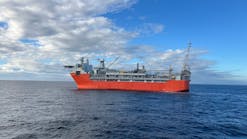Roughnecks of Sherwood Forest
A "roughneck" is a slang term for a person completing dangerous, hard-manual labor in the working environment of an oil rig. A roughneck's main duties include connecting pipe down the wellbore as well as general work around a rig. The crew of a land-based rig can be further divided into several positions such as drillers, derrickmen, roustabouts, and motormen.
While doing research on the Worldwide Report, which reports oil production by field, this editor ran across an article from the American Oil & Gas Historical Society of how roughnecks helped save the future of Great Britain during World War II.
During a time of great desperation, the future of Great Britain and the outcome of World War II were at risk. A war dependent on petroleum supplies, demand rose to nearly 150,000 b/d of 100-octane aviation fuel by the end of 1942. That summer, the British Sec. of Petroleum Geoffrey Lloyd announced an emergency meeting of the Oil Control Board (OCB) to discuss the "impending crisis in oil."
The British Admiralty was suffering from U-boat attacks, along with bombing of dockside storage facilities; these actions hurt the petroleum supplies, falling below the minimum of 2 million bbl of safety reserves.
The 'unsinkable tanker'
Principal fuel supplies, primarily coming from Trinidad and Tobago as well as the US, were constantly under attack from Nazi submarines.
During the OCB meeting, some members were astonished to learn that England had a productive oil field discovered by D'Arcy Exploration in 1939. D'Arcy was a subsidiary of Anglo-Iranian Oil Co., the predecessor to British Petroleum. The vague oil field in Sherwood Forest, near Eakring and Dukes Wood, produced a meager 700 b/d from 50 shallow wells. Without drilling equipment and labor availability, the field was not developed further.
Under strict secrecy, an engineer from D'Arcy, CAP Southwell, was sent to Washington, DC, to discuss assistance with the Petroleum Administration for War (PAW). Southwell's mission was to obtain US support to increase production from Eakring field, labeled the "unsinkable tanker." Independent oilman Lloyd Noble, president of the then-Tulsa-based Noble Drilling Corp., was pursued by Southwell to negotiate a deal in helping expand Eakring. Noble, in cooperation with Fain-Porter Drilling Co. of Oklahoma City, volunteered to execute a contract for cost and expense only, for the drilling of 100 wells in Eakring field. PAW signed the contract in February 1943.
By Mar. 12, 1943, a team of 42 drillers, derrickmen, roustabouts, and motormen boarded the troopship HMS Queen Elizabeth. Soon to follow, four drilling rigs shipped separately to England, with one ship going down due to a German submarine.
The English project
Within a month, equipment arrived and spudding of the first well took place. Working 12-hr shifts, four different crews quickly brought on two more wells. The British colleagues were stunned at the American's speed of drilling. Current innovative drilling methods achieved an average of 1 well/week at Duke's Wood, while the Brits would drill 1 well in 5 weeks.
The project came to an end in March 1944, completing 106 wells with 94 producers. England's oil production rose from 300 b/d to more than 3,000 b/d of high-quality oil in just a year's time. This accomplishment, however, came with a cost: Derrickman Herman Douthit died from a fall from a drilling mast. He received full military honors and remains the only private citizen to be buried at the American Military Cemetery in Cambridge, England.
More than 3.5 million bbl of crude had been produced from England's "unsinkable tanker" oil fields by the end of the war, using 2.3 million bbl for the war effort alone. To commemorate this virtually unknown story of partnership, bronze statues of an identical Oil Patch Warrior were erected in both England and Ardmore, Okla.

Laura Bell-Hammer | Statistics Editor
Laura Bell-Hammer has been the Statistics Editor for the Oil & Gas Journal since 1994. She was the Survey Editor for two years prior to her current position with OGJ. While working with OGJ, she also was a contributing editor for Oil & Gas Financial Journal. Before joining OGJ, she worked for Vintage Petroleum in Tulsa, gaining her oil and gas industry knowledge.
